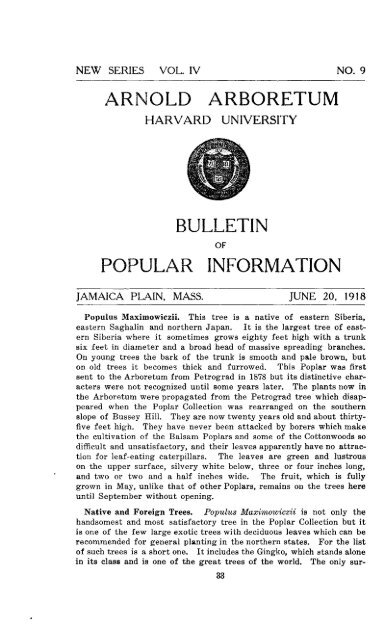Open as a single document - Arnoldia - Harvard University
Open as a single document - Arnoldia - Harvard University
Open as a single document - Arnoldia - Harvard University
You also want an ePaper? Increase the reach of your titles
YUMPU automatically turns print PDFs into web optimized ePapers that Google loves.
NEW SERIES VOL. IV NO. 9<br />
ARNOLD ARBORETUM<br />
HARVARD UNIVERSITY<br />
BULLETIN<br />
OF<br />
POPULAR INFORMATION<br />
JAMAICA PLAIN, MASS. JUNE 20, 1918<br />
Populus Maximowiczii. This tree is a native of e<strong>as</strong>tern Siberia,<br />
e<strong>as</strong>tern Saghalin and northern Japan. It is the largest tree of e<strong>as</strong>tern<br />
Siberia where it sometimes grows eighty feet high with a trunk<br />
six feet in diameter and a broad head of m<strong>as</strong>sive spreading branches.<br />
On young trees the bark of the trunk is smooth and pale brown, but<br />
on old trees it becomes thick and furrowed. This Poplar w<strong>as</strong> first<br />
sent to the Arboretum from Petrograd in 1878 but its distinctive characters<br />
were not recognized until some years later. The plants now in<br />
the Arboretum were propagated from the Petrograd tree which disappeared<br />
when the Poplar Collection w<strong>as</strong> rearranged on the southern<br />
slope of Bussey Hill. They are now twenty years old and about thirtyfive<br />
feet high. They have never been attacked by borers which make<br />
the cultivation of the Balsam Poplars and some of the Cottonwoods so<br />
difficult and unsatisfactory, and their leaves apparently have no attraction<br />
for leaf-eating caterpillars. The leaves are green and lustrous<br />
on the upper surface, silvery white below, three or four inches long,<br />
and two or two and a half inches wide. The fruit, which is fully<br />
grown in May, unlike that of other Poplars, remains on the trees here<br />
until September without opening.<br />
Populus Maximowiczii is not only the<br />
Native and Foreign Trees.<br />
handsomest and most satisfactory tree in the Poplar Collection but it<br />
is one of the few large exotic trees with deciduous leaves which can be<br />
recommended for general planting in the northern states. For the list<br />
of such trees is a short one. It includes the Gingko, which stands alone<br />
in its cl<strong>as</strong>s and is one of the great trees of the world. The only sur-<br />
33

















